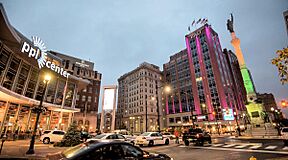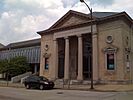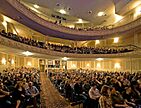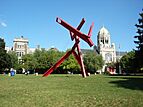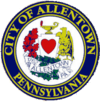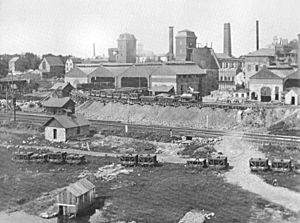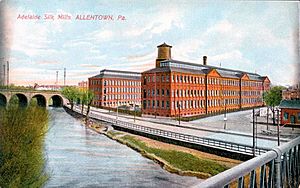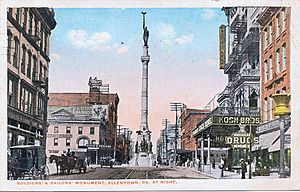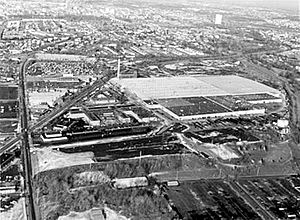Allentown, Pennsylvania facts for kids
Quick facts for kids
Allentown, Pennsylvania
|
|||||
|---|---|---|---|---|---|
|
Home rule municipality
|
|||||
|
Americus Hotel on Hamilton Street
Muhlenberg College
|
|||||
|
|||||
| Nicknames:
"The A" "The Queen City", "A-Town", "Band City USA", "Peanut City", "Silk City".
|
|||||
| Motto(s): | |||||
| Country | United States | ||||
| State | Pennsylvania | ||||
| County | Lehigh | ||||
| Settled | 1751 | ||||
| Founded | 1762 | ||||
| Incorporated | March 12, 1867 | ||||
| Founded by | William Allen | ||||
| Named for | William Allen | ||||
| Government | |||||
| • Type | Mayor-council | ||||
| Area | |||||
| • Home rule municipality | 18.01 sq mi (46.64 km2) | ||||
| • Land | 17.56 sq mi (45.49 km2) | ||||
| • Water | 0.44 sq mi (1.15 km2) | ||||
| • Urban | 261.55 sq mi (677.4 km2) | ||||
| • Metro | 730.0 sq mi (1,174.82 km2) | ||||
| Elevation | 338 ft (103 m) | ||||
| Highest elevation | 440 ft (130 m) | ||||
| Lowest elevation | 255 ft (78 m) | ||||
| Population
(2020)
|
|||||
| • Home rule municipality | 125,845 | ||||
| • Rank | 1st in the Lehigh Valley 3rd in Pennsylvania |
||||
| • Density | 7,164.94/sq mi (2,766.35/km2) | ||||
| • Urban | 621,703 (US: 68th) | ||||
| • Urban density | 2,377.0/sq mi (917.8/km2) | ||||
| • Metro | 865,310 (US: 68th) | ||||
| • Metro density | 1,117.8/sq mi (431.6/km2) | ||||
| • Demonym | Allentonian | ||||
| Time zone | UTC−5 (EST) | ||||
| • Summer (DST) | UTC−4 (EDT) | ||||
| ZIP Codes |
18101, 18102, 18103, 18104, 18105, 18106, 18109, 18175, and 18195
|
||||
| Area codes | 610 and 484 | ||||
| FIPS code | 42-02000 | ||||
| GNIS feature ID | 1202899 | ||||
| Primary airport | Lehigh Valley International Airport- ABE (Major/International) | ||||
| Secondary airport | Allentown Queen City Municipal Airport- XLL (Minor) | ||||
| School district | Allentown | ||||
| Major hospital | Lehigh Valley–Cedar Crest | ||||
Allentown is a cool city in Pennsylvania, located in Lehigh County. It's the third-largest city in the state, with over 125,000 people living there. Allentown is also the biggest city in the Lehigh Valley area, which has a population of over 860,000 people.
The city was started in 1762 and sits right by the Lehigh River. It's part of a group of three cities, including Bethlehem and Easton, in eastern Pennsylvania. Allentown is about 48 miles north of Philadelphia and 78 miles west of New York City.
Contents
- History of Allentown
- Geography of Allentown
- People of Allentown
- Allentown's Economy
- Culture in Allentown
- Allentown's Food
- Landmarks and Popular Spots
- Music in Allentown
- Parks in Allentown
- Fun and Recreation
- Sports in Allentown
- Education in Allentown
- Media in Allentown
- Transportation in Allentown
- City Services
- Famous People from Allentown
- See also
History of Allentown
Early Days in the 1700s
Long ago, in the early 1700s, the area where Allentown is now was wild land. The Lenape, a Native American tribe, lived there. They fished in the creeks and hunted deer. In 1736, a large piece of this land was bought from 23 Native American chiefs by the sons of William Penn. He was the founder of Pennsylvania.
Later, in 1735, a wealthy merchant named William Allen bought 5,000 acres of this land. He was also a former mayor of Philadelphia. Allen built a log house around 1740. He used it for hunting and fishing, and to host important guests.
In 1762, William Allen officially planned and named the city. He hoped it would become a big center for business. He even named many streets after his children, like Margaret (now 5th Street) and William (now 6th Street). The city was first called Northampton Towne. In 1767, Allen gave the land to his son, James.
Allentown and the American Revolution
Allentown played a big part in the American Revolution. People in the area started to resist British rule early on. In 1774, a group called the Committee of Observation was formed by local patriots. After the Declaration of Independence, these patriot groups grew stronger. They even pushed out people who supported the British.
During the war, Allentown helped by keeping Hessian prisoners. It also had four hospitals to treat wounded American soldiers. George Washington, the leader of the American army, even passed through Allentown with his troops. They stopped to rest and water their horses.
In 1777, a factory that made paper cartridges and muskets for the army moved to Allentown. A shop with 16 armorers also opened. They repaired weapons and made saddles for the soldiers.
The Liberty Bell's Secret Hiding Place
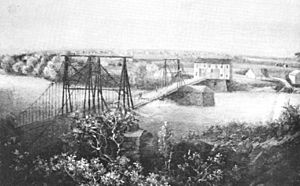
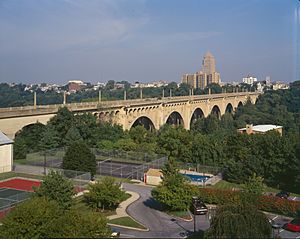
Allentown is famous for being the secret hiding place of the Liberty Bell during the Revolutionary War! In 1777, after the British took over Philadelphia, American patriots worried they would melt down the bell for weapons.
So, they took 11 bells, including the Liberty Bell, and moved them to Allentown. Two farmers, John Snyder and Henry Bartholomew, transported the bells. They hid the Liberty Bell under the floorboards of the Zion Reformed Church. It stayed safe there for nine months until the war moved on.
Allentown in the 1800s
In 1803, Allentown got its first post office. By 1810, over 700 people lived in the city. In 1811, it officially became the Borough of Northampton. The next year, it became part of Lehigh County.
Allentown grew as a town for courts and markets. The first bank opened in 1814. The first Hamilton Street Bridge was built over the Lehigh River. In 1829, the Lehigh Canal was finished. This canal helped transport coal to big cities like New York and Philadelphia. Later, in 1855, the first railroad came to Allentown. Trains soon became more important than canals for moving coal.
In 1838, the city's name officially changed to Allentown. But it faced some tough times. In 1841, a flood destroyed the Hamilton Street Bridge. In 1843, the local bank failed, causing financial problems for many. Then, in 1848, a big fire burned down much of the downtown area.
But Allentown bounced back! A new bridge was built, and brick buildings replaced the burned wooden ones. In 1852, the first Allentown Fair was held. It's still one of the oldest continuous fairs in the country.
Allentown During the Civil War
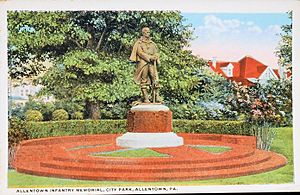
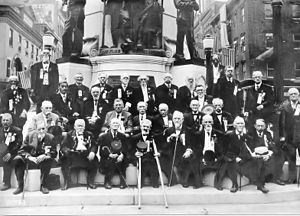
When the American Civil War started in 1861, Allentown quickly supported the federal government. Local citizens formed new military units. These units, including the Allen Rifles, were among the first to answer President Lincoln's call for volunteers. They helped defend Washington, D.C..
Many of these soldiers were called "Pennsylvania First Defenders." After their first duty, many joined the Union Army again. One important unit was the 47th Pennsylvania Infantry Regiment. Soldiers from Allentown and nearby towns joined this group. They fought in many battles, including in Florida, South Carolina, Louisiana, and Virginia.
In 1899, Allentown put up the Soldiers and Sailors Monument in Center City. It honors the brave Union soldiers from Allentown and the Lehigh Valley who died in the Civil War.
Allentown's Industrial Growth
Allentown slowly grew into a center for business and factories. Before the American Revolution, it had about 330 people. By 1795, it had around 90 homes, churches, and mills.
The opening of the Lehigh Canal in 1818 really changed Allentown. It helped turn the area from a farming community into one of America's first industrial places. Allentown became a major center for heavy industry and manufacturing.
Factories started to open. By 1814, Allentown had flour mills, sawmills, and shops making saddles, guns, and clocks. In the 1840s, iron ore was found nearby. This led to the opening of iron furnaces and other metal product factories. The Allentown Rolling Mill Company became the biggest iron company.
During the Civil War, many new businesses opened. These included brick yards, shoe factories, and breweries. One shoe store, Leh's, became a major supplier of military boots for the Union Army.
In 1883, Allentown Boiler Works was founded. They made iron products used in famous buildings like the White House. Their products were sold all over the world. Brick factories also did well, and Allentown bricks were shipped across the country.
In the late 1870s, the iron industry struggled. So, Allentown looked for new industries. They brought in silk mills. The city quickly became a national leader in silk manufacturing. By 1914, there were 26 silk mills, and by the 1940s, over 10,000 people worked in the silk industry.
In 1896, Max Hess opened Hess Brothers, Allentown's first department store. It was known for fancy European fashion. Other big stores like Zollinger-Harned Company also opened. Allentown also became known for its beer breweries.
Allentown in the 1900s
In 1905, Mack Trucks moved its company to Allentown. By 1914, Mack Trucks was famous for making strong trucks. Many of their trucks were sent to France during World War I. The British even called their trucks "Bulldogs," which became Mack's company symbol.
Many people in Allentown continued to speak Pennsylvania German into the early 1900s. It was a big part of the local culture.
After World War II in 1945, Western Electric opened a factory in Allentown. In 1951, this factory made the world's first transistor. This made Allentown a leader in the new electronics industry.
By the mid-1900s, Allentown was a big shopping and entertainment center. Department stores like Hess's and Leh's, along with many smaller shops and theaters, made downtown Allentown a busy place.
Changes and Challenges in the Late 1900s
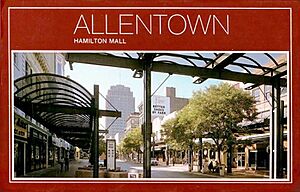
In the 1960s, things started to change. Taxes in Allentown went up, and people began moving to the suburbs. These areas had lower taxes, more green space, and newer schools. Many working-class families left Allentown.
As families left, many homes in Center City were turned into apartments. The city tried to improve its main shopping street, Hamilton Street, by creating the Hamilton Mall. But many stores still closed because people were shopping at new malls in the suburbs, like Whitehall Mall and Lehigh Valley Mall.
Allentown in the 2000s
Allentown's factories and businesses faced tough times in the late 1900s and early 2000s. Many closed or moved away. This led to a loss of high-paying factory jobs. Allentown became known as a "Rust Belt" city, meaning its old industries were declining.
To fix this, Allentown started to change its economy. In the 2000s and 2010s, new jobs grew in health care, transportation, and other services. In 2009, the state created the Neighborhood Improvement Zone (NIZ). This special zone in Center City helps new businesses and projects get started.
In 2014, a big change happened in Center City. The PPL Center, a large arena, opened. It's now home to the Lehigh Valley Phantoms hockey team and hosts many concerts and events. A new hotel also opened.
In 2024, U.S. News & World Report said Allentown was the fifth-best place in the U.S. to retire!
Geography of Allentown
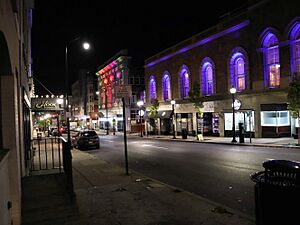
Allentown's Landscape
Allentown covers about 18 square miles. Most of it is land, with a small amount of water. Rivers and creeks like Jordan Creek and Little Lehigh Creek flow through the city. They eventually join the Lehigh River. You can also find Lake Muhlenberg and a pond in Trexler Park.
Allentown is in the Lehigh Valley. This valley is between two mountain ridges: Blue Mountain to the north and South Mountain to the south.
City Areas and Neighborhoods
Center City is the main part of Allentown. It has downtown shops, offices, and government buildings. To the east are older neighborhoods called The Wards. The East Side neighborhoods are across the Lehigh River. South of Center City are the South Side neighborhoods. The West End, west of 15th Street, has a mix of businesses, cultural spots, and larger homes.
The tallest building in Center City is the PPL Building. It's 322 feet tall! The PPL Center arena is also in Center City. Other important places include the Allentown Art Museum, Baum School of Art, and Miller Symphony Hall.
Allentown's Architecture
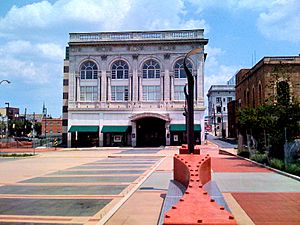
Allentown has many old and historic buildings. You can see Victorian and rowhouses in Center City. The West Park area has Victorian and American Craftsman-style homes. Houses in the West End were built mostly in the 1920s to 1940s. The East and South Sides have a mix of styles, mostly built from the 1940s to 1960s. Many old factories have been turned into cool loft apartments.
Allentown has three main historic areas: Old Allentown, the Old Fairgrounds, and West Park.
The PPL Building is a famous landmark. It was built between 1926 and 1928. Its design even inspired parts of Rockefeller Center in New York City. The building is lit up every night and can be seen from far away.
Miller Symphony Hall opened in 1896 as a public market. It later became a theater and is now home to the Allentown Symphony Orchestra. It has hosted many different shows for over 100 years.
Allentown's Climate
Allentown has warm and humid summers. Fall and spring are usually mild. Winters are cool to cold. It rains or snows pretty evenly throughout the year.
In January, the average temperature is about 30 degrees Fahrenheit. The coldest temperature ever recorded was -15 degrees Fahrenheit. In July, the average is about 75 degrees Fahrenheit. The hottest temperature ever was 105 degrees Fahrenheit.
Allentown gets about 33 inches of snow each winter. February usually gets the most snow. It rains about 110 centimeters (43 inches) per year.
People of Allentown
Population Changes
Allentown's population has grown over the years. In 2020, there were 125,845 people living in the city.
The number of Hispanic people in Allentown has grown a lot. In 1990, about 12% of the city was Hispanic. By 2024, it's estimated to be around 55%. Many of these residents are from Dominican Republic and Puerto Rico.
| Race / Ethnicity (NH = Non-Hispanic) | Pop 1980 | Pop 1990 | Pop 2000 | Pop 2010 | Pop 2020 | % 1980 | % 1990 | % 2000 | % 2010 | % 2020 |
|---|---|---|---|---|---|---|---|---|---|---|
| White alone (NH) | 94,508 | 86,510 | 68,621 | 50,964 | 38,033 | 91.09% | 82.32% | 64.35% | 43.18% | 30.22% |
| Black or African American alone (NH) | 3,047 | 4,639 | 7,284 | 11,336 | 13,193 | 2.94% | 4.41% | 6.83% | 9.60% | 10.48% |
| Native American or Alaska Native alone (NH) | 111 | 126 | 165 | 200 | 150 | 0.11% | 0.12% | 0.15% | 0.17% | 0.12% |
| Asian alone (NH) | 693 | 1,363 | 2,375 | 2,452 | 2,498 | 0.67% | 1.30% | 2.23% | 2.08% | 1.98% |
| Pacific Islander alone (NH) | N/A | N/A | 49 | 11 | 28 | N/A | N/A | 0.05% | 0.01% | 0.02% |
| Some Other Race alone (NH) | 105 | 178 | 136 | 224 | 805 | 0.10% | 0.17% | 0.13% | 0.19% | 0.64% |
| Mixed race or Multiracial (NH) | N/A | N/A | 1,944 | 2,384 | 2,906 | N/A | N/A | 1.82% | 2.02% | 2.31% |
| Hispanic or Latino (any race) | 5,294 | 12,274 | 26,058 | 50,461 | 68,232 | 5.10% | 11.68% | 24.44% | 42.75% | 54.22% |
| Total | 103,758 | 105,090 | 106,632 | 118,032 | 125,845 | 100.00% | 100.00% | 100.00% | 100.00% | 100.00% |
Allentown's Economy
Allentown used to be a big center for factories and manufacturing. But now, its economy has changed to focus more on services. This happened because many heavy industries declined.
Today, Allentown is home to the main offices of companies like Air Products and PPL Corporation. The biggest employer in the city is Lehigh Valley Health Network, with over 7,800 employees. Their main hospital, Lehigh Valley Hospital–Cedar Crest, is one of the largest in Pennsylvania.
Center City used to be the main shopping area. But now, many people shop at malls in the suburbs, like South Mall, Lehigh Valley Mall, and Whitehall Mall. There's also The Promenade Shops at Saucon Valley south of Allentown.
Culture in Allentown
Arts and Theater
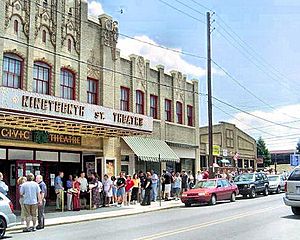
The Allentown Symphony Orchestra performs at Miller Symphony Hall in Center City. Allentown is also famous for its civilian concert bands. The Allentown Band is the oldest civilian concert band in the country!
You can find cool public sculptures in Allentown, like the DaVinci Horse. The Allentown Art Museum has over 13,000 pieces of art. The Baum School of Art offers classes in painting, drawing, and other arts.
The Civic Theatre of Allentown has been putting on plays for over 90 years. It's also the only full-time movie theater in the Lehigh Valley that shows art and independent films. They also have a theater school for young people.
Museums and Cultural Places
- Allentown Art Museum: An art museum.
- Allentown Band: The nation's oldest civilian concert band.
- Allentown Symphony Orchestra: A symphony orchestra.
- America on Wheels: A museum about cars and transportation.
- Baum School of Art: A non-profit art school for the community.
- Civic Theatre of Allentown: A historic movie theater.
- Da Vinci Science Center: A science museum.
- Lehigh County Historical Society: A local history museum.
- Marine Band of Allentown: A civilian concert band.
- Municipal Band of Allentown: A civilian concert band.
- Museum of Indian Culture: An educational center about the Lenape Indian tribe.
Allentown's Food
Allentown's food has a lot of Pennsylvania Dutch influence. You can find foods like scrapple, chow-chow, Lebanon bologna, and apple butter in local diners and at the Allentown Farmer's Market. Sweet treats like shoofly pie, birch beer, and funnel cakes are popular at fairs. Many churches sell fastnachts (a type of doughnut) before Lent.
Because Allentown is close to Philadelphia, cheesesteaks are very popular here. Yocco's Hot Dogs, a famous hot dog and cheesesteak place, was started in 1922. A-Treat Bottling Company, a popular soft drink company, has been based in Allentown since 1918.
Landmarks and Popular Spots
The Soldiers and Sailors Monument stands in Allentown's Center Square. It was put up in 1899 to honor the soldiers from Allentown and the Lehigh Valley who died fighting in the American Civil War. The monument has a statue of the Goddess of Liberty on top. Allentown's motto is in Latin: Sic semper tyrannis, which means "thus always to tyrants."
Music in Allentown
The Allentown Band, Marine Band of Allentown, and Municipal Band of Allentown often perform at the bandshell in West Park. J. Birney Crum Stadium, a large high school football field, hosts the Drum Corps International's Eastern Classic. This event brings together the best junior drum and bugle corps in the world.
Parks in Allentown
Many of Allentown's parks were created thanks to a man named Harry Clay Trexler. He helped build West Park, which used to be a trash pit. This park, opened in 1909, has a bandshell where local bands perform. Trexler also helped develop Trexler Park, Cedar Parkway, and Lehigh Parkway. He set up a trust to help fund the parks' care.
Allentown's parks include Bicentennial Park (a small stadium), Cedar Creek Parkway (with Lake Muhlenberg and a rose garden), Lehigh Parkway (a large park with a trout nursery), and West Park.
Fun and Recreation
Amusement Park Fun
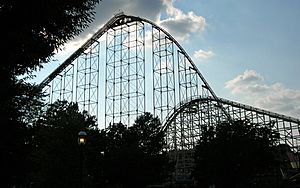
Allentown is home to Dorney Park & Wildwater Kingdom, one of the biggest amusement and water parks in the country. Dorney Park's Steel Force roller coaster is one of the longest steel roller coasters in the world!
Festivals and Events
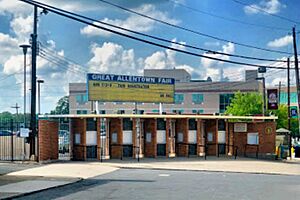
The Great Allentown Fair happens every year in late August and early September at the Allentown Fairgrounds. The first fair was held in 1852!
Blues, Brews, and Barbeque is a blues music festival held every June on Hamilton Street in Center City. In May, the Mayfair Festival of the Arts is a three-day art festival held at Cedar Crest College.
Sports in Allentown
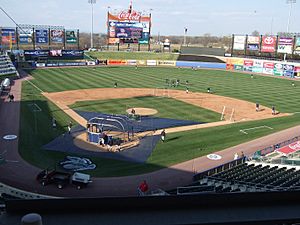
The Lehigh Valley area, including Allentown, is known for great high school sports. Many professional and Olympic athletes have started their careers here.
College Sports
Both Cedar Crest College and Muhlenberg College in Allentown have many sports teams. The Muhlenberg Mules play their home football games at Scotty Wood Stadium on the Muhlenberg campus.
High School Sports
Allentown has three big high schools: Allen, Dieruff, and Central Catholic. They all compete in the Eastern Pennsylvania Conference, which is one of the best high school sports divisions in the country. All three high schools play their home football games at J. Birney Crum Stadium, the largest high school football stadium in the Mid-Atlantic region.
Lehigh Valley IronPigs Baseball
Professional baseball has a long history in Allentown, going back to 1884. Today, Allentown is home to the Lehigh Valley IronPigs. They are the Triple-A team for the Philadelphia Phillies. They play at Coca-Cola Park, a modern stadium on Allentown's east side.
Lehigh Valley Phantoms Ice Hockey
Allentown is also home to the Lehigh Valley Phantoms. They are the main development team for the Philadelphia Flyers (an NHL team). The Phantoms play their games at PPL Center, a large indoor arena in Center City.
Parkettes Gymnastics
Allentown has the Parkettes National Gymnastics Training Center. Many Olympians and U.S. national gymnastics champions have trained here.
Education in Allentown
Schools for Kids and Teens
The Allentown School District runs most of the public schools in the city. Allentown has two large public high schools for grades 9-12: William Allen High School and Louis E. Dieruff High School. Both high schools, along with Allentown Central Catholic High School (a private school), play their home football games at J. Birney Crum Stadium.
The city has four middle schools for grades 6-8 and 16 elementary schools for kindergarten through fifth grade. Allentown also has two public charter schools: Roberto Clemente Charter School and Lincoln Leadership Academy Charter School. There are also several private and religious schools in Allentown.
Colleges and Universities
Allentown has two four-year colleges: Cedar Crest College and Muhlenberg College. There is also a campus of Lehigh Carbon Community College (LCCC), which offers two-year and four-year degrees.
Media in Allentown
TV and Radio
Allentown is part of the Philadelphia TV market, which is one of the biggest in the country. You can watch major TV channels like CBS, NBC, ABC, and Fox from Philadelphia. Allentown also has its own TV stations, WFMZ-TV Channel 69 and WLVT-TV Channel 39 (PBS).
Allentown is also a big radio market. Many local radio stations play different kinds of music and talk shows. You can also pick up radio stations from New York City and Philadelphia.
Newspapers and Magazines
Allentown has two daily newspapers, The Morning Call and The Express-Times. There are also several weekly and monthly magazines that cover news and people in Allentown.
Transportation in Allentown
Airports for Travel
The main airport for Allentown is Lehigh Valley International Airport. It's just a few miles northeast of the city. You can fly directly to many big cities from here. There's also a smaller airport, Allentown Queen City Municipal Airport, mostly used by private planes.
Roads and Highways

Allentown has many public roads. Interstate 78 and Pennsylvania Route 309 pass through the southern part of the city. U.S. Route 22 also goes through the northwestern part. These highways connect Allentown to other cities like Philadelphia and New York.
Bus Services
Public buses in Allentown are run by LANta. The Allentown Transportation Center is a main hub for these buses. You can also take private bus lines like Trans-Bridge Lines and Greyhound Lines from Allentown to places like New York City and Philadelphia.
Train Services
Allentown is an important center for moving goods by train. Large freight trains use the city's rail lines. In the past, Allentown had many passenger train services connecting it to cities all over the Northeast. There are plans to bring back passenger train service between Allentown and New York City by 2035.
City Services
Utilities
Electricity in Allentown is provided by PPL Corporation. UGI Corporation supplies natural gas. Two companies, RCN Corporation and Service Electric, provide cable TV service. The city also manages waste and recycling.
Fire Department
The Allentown Fire Department started in 1870. It has six fire stations around the city to keep everyone safe.
Famous People from Allentown
Since it was founded in 1762, many notable Americans have been born or lived in Allentown, including:
- Saquon Barkley, professional football player
- Chakaia Booker, sculptor
- Lillian Briggs, rock music singer
- Dane DeHaan, film and television actor
- Lee Iacocca, former chairman of Chrysler
- Keith Jarrett, jazz musician
- Sarah Knauss, the longest-lived American ever
- Carson Kressley, television personality
- Ed McCaffrey, professional football player
- Lara Jill Miller, actress and voice actress
- Aimee Mullins, Paralympian, model, actress
- Lil Peep, emo rapper and singer
- Andre Reed, professional football player and Hall of Famer
- Amanda Seyfried, actress
- Christine Taylor, actress
- Lauren Weisberger, author of The Devil Wears Prada
See also
 In Spanish: Allentown (Pensilvania) para niños
In Spanish: Allentown (Pensilvania) para niños


